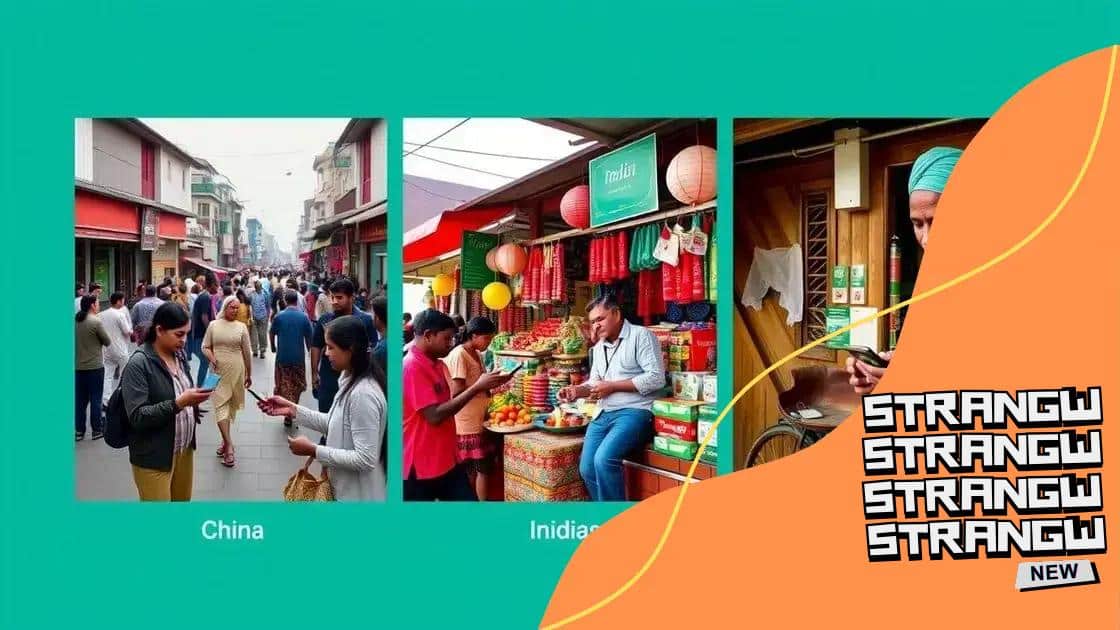Mobile payment innovations in emerging markets

Mobile payment innovations in emerging markets are transforming transactions by integrating technologies like AI, cryptocurrency, and biometric security, while addressing challenges related to trust and infrastructure.
Mobile payment innovations in emerging markets are changing the way people handle transactions. Have you ever wondered how these developments affect daily life and economic growth? Let’s dive into this fascinating topic.
Overview of mobile payment landscape
The mobile payment landscape is evolving rapidly, especially in emerging markets. These regions are adopting new technologies at an astonishing rate, revolutionizing how consumers and businesses conduct transactions. As smartphones become more accessible, a significant shift towards mobile payments is evident.
Growth of Mobile Payments
Recent studies indicate that mobile payment transactions are growing exponentially. The rise in smartphone usage and internet connectivity is a crucial driver behind this trend. As people recognize the convenience and speed of mobile payments, adoption rates soar.
Key Players and Innovations
Several key players lead the charge in the mobile payment sector:
- Financial Technology Startups: Innovating how payments are processed.
- Telecom Companies: Offering mobile wallets with integrated services.
- Major Banks: Partnering with tech firms to develop user-friendly apps.
These organizations are making it easier to send and receive money without the need for cash or cards. The emergence of digital wallets and near-field communication (NFC) technologies enhances user experience, making transactions simpler and safer.
Challenges in Adoption
Despite the rapid growth, certain challenges remain:
- Trust Issues: Consumers are often hesitant to adopt new payment methods.
- Data Security: Protecting users’ information is paramount.
- Infrastructure: In rural areas, internet connectivity can be inconsistent.
Addressing these challenges is vital to ensure the continued growth of the mobile payment landscape. As solutions develop, it will be interesting to see how this space evolves in the coming years.
Key technologies driving innovation
Several key technologies are driving innovation in the mobile payment sector. Understanding these technologies helps to appreciate how they enhance user experience and security. As the market expands, these advancements are becoming increasingly vital.
Contactless Payments
Contactless payments, enabled by NFC (Near Field Communication), allow users to make purchases simply by tapping their smartphones at payment terminals. This technology provides a quick and seamless experience. Many people enjoy the convenience, which helps to drive further adoption of mobile payments.
Mobile Wallets
Mobile wallets are applications that store users’ payment information securely and allow them to make transactions from anywhere. They often include additional features, such as loyalty programs and transaction history, making them more appealing.
- Examples include PayPal, Apple Pay, and Google Wallet.
- Users can link their bank accounts or credit cards for easy access.
- Most mobile wallets offer enhanced security measures like biometric authentication.
As more businesses integrate mobile wallets into their systems, consumers experience greater flexibility.
Blockchain Technology
Blockchain is another revolutionary force in the mobile payment landscape. This technology enables secure, transparent transactions that can reduce fraud and lower costs. While still emerging, the potential of blockchain in shaping the future of transactions is highly promising.
In addition, peer-to-peer payment systems are making it easier for individuals to exchange money without needing a bank. These platforms create a safer environment for mobile commerce, expanding market access.
Case studies from leading countries

Examining case studies from leading countries provides insight into effective mobile payment strategies. Different regions implement unique solutions based on their market needs and technologies.
China’s Pioneering Mobile Payments
China stands out as a global leader in mobile payments. Platforms like WeChat Pay and Alipay dominate the market, making cash transactions virtually obsolete in many urban areas. Users can pay for everything from groceries to public transport through these apps.
India’s Rapid Growth
India is witnessing a swift increase in mobile payment adoption. The Unified Payments Interface (UPI) is a game-changer, allowing instant bank transfers between users. This innovation has been vital in promoting digital payments in rural communities.
- Over 300 million users are now on UPI.
- Various apps, like PhonePe and Paytm, facilitate transactions.
- Government initiatives promote cashless transactions.
This rapid expansion reflects a broader trend toward digitization in India, showing how mobile payment can empower users.
Kenya’s M-Pesa Success
In Kenya, M-Pesa has transformed the lives of many people. This mobile money service allows users to send money and make payments easily, even without a bank account. M-Pesa has particularly improved financial inclusion for unbanked populations.
Lessons from these countries reveal that successful mobile payment systems depend on user-friendly technology, government support, and addressing local needs. Each case demonstrates thriving ecosystems fueled by innovation.
Challenges faced in adoption
Even with the rapid growth of mobile payment systems, several challenges hinder widespread adoption. Recognizing these obstacles is essential for improving the experience and ensuring better access for all users.
Trust and Security Concerns
One of the primary challenges is building trust among potential users. Many individuals fear that their personal information may be compromised. Issues with fraud and the security of their financial data make users hesitant to adopt mobile payment solutions.
- Data breaches: High-profile breaches can shake confidence.
- Lack of knowledge: Some people are not aware of security features.
- Limited customer support: Users may feel lost without adequate help.
Education and clear communication from service providers can help mitigate these concerns and encourage more users to adopt these technologies.
Infrastructure Issues
In many emerging markets, the infrastructure for mobile payments may not be fully developed. Limited access to reliable internet or mobile networks can restrict users from engaging in digital transactions. Moreover, the availability of smartphones is also a crucial factor.
Ongoing investment in infrastructure is essential. Governments and private companies must work together to enhance connectivity and accessibility across all regions.
Regulatory Challenges
Regulatory frameworks are often lagging behind technology in the mobile payment industry. Different countries have varying rules, which can create confusion and uncertainty for users and businesses. Developing a uniform regulatory approach could help stabilize and grow mobile payment adoption.
These challenges highlight the need for a collaborative effort between tech companies, governments, and users. By addressing trust, infrastructure, and regulation, the mobile payment landscape can continue to expand.
Future trends in mobile payments
Looking ahead, several future trends are likely to shape the landscape of mobile payments. These trends can enhance user experiences and broaden the adoption of digital transactions across various demographics.
Increased Adoption of Cryptocurrency
The rise of cryptocurrencies is changing how people think about money. Many mobile payment platforms now allow users to pay with digital currencies. This trend enables greater flexibility and inclusivity in financial transactions.
Integration of Artificial Intelligence
Artificial Intelligence (AI) is set to play a significant role in mobile payments. AI can help personalize user experiences and improve security through advanced fraud detection. With machine learning algorithms, systems can analyze user behavior and identify potential risks in real-time.
- AI can enhance payment processing speed.
- Custom recommendations will lead to improved user retention.
- Smart chatbots can offer immediate customer support.
This integration can make mobile payments even more appealing.
Expansion of Biometric Authentication
As security becomes a top priority, banks and payment providers are focusing on biometric authentication methods. Fingerprint recognition and facial recognition technologies make transactions faster and safer. By incorporating biometrics, companies can greatly reduce the risk of fraud and increase user confidence.
As technology continues to advance, mobile wallets will also likely include more features such as virtual cards and integration with loyalty programs. This could simplify the shopping experience and encourage consumers to switch from cash to mobile payments.
These developments show that the future of mobile payments is bright. By focusing on innovation and user needs, the industry can grow and adapt in exciting ways.
FAQ – Frequently Asked Questions about Mobile Payment Innovations
What are the main advantages of mobile payments?
Mobile payments offer convenience, speed, and enhanced security, allowing users to make transactions quickly and easily from their smartphones.
How is cryptocurrency affecting mobile payments?
Cryptocurrency adoption is growing in the mobile payment sector, enabling users to transact using digital currencies, which increases flexibility in payments.
What role does AI play in mobile payments?
AI enhances mobile payment systems by improving security through fraud detection and offering personalized experiences for users.
What challenges do users face with mobile payment adoption?
Users often face trust issues regarding security, lack of infrastructure in some regions, and regulatory uncertainty, which can hinder adoption.





